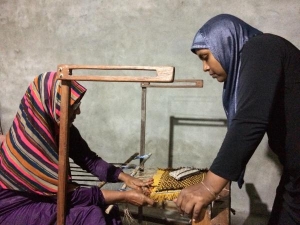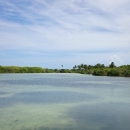Newsroom :: News :: Healthy wetlands, better lives: Traditional mat weaving as a sustainable livelihood in the Maldives
Healthy wetlands, better lives: Traditional mat weaving as a sustainable livelihood in the Maldives
Location: Fiyoaree, Maldives. 5th Mar 2018
With a population of 400,000 and a unique cultural heritage, life on the islands has traditionally been one of self-sustenance and living in harmony with nature. On the island of Fiyoaree in Southern Huvadhoo Atoll, local communities have demonstrated how benefiting from the island ecosystems can be done sustainably.
A tidal mangrove ecosystem in the island of Fiyoaree. Maldives also harbors diverse island mangrove ecosystem in addition to the 7th largest reef system and pristine beaches. © Abdulla Adam
Local Knowledge
For two centuries, the locals in Fiyoaree have perfected the art of weaving mats by using a local reed known for its durability and lightness. While this reed grows in wetlands found in other islands, it is a widely believed that the reed found in the Fiyoaree marshland is of a higher quality. This can be largely attributed to increased nutrients it receives through application of ash and other organic matter by locals.
Apart from better quality reeds, Fiyoaree’s marshland provides other benefits to the residents. The marshland, which mitigates floods during the rainy season, is also where the islanders grow Taro – a type of root vegetable which is consumed as a staple, especially in the southern islands.
The art of mat weaving stands out thanks to the intricate skills required, the sophisticated and detailed designs, and the knowledge that goes into the weaving – from the cultivation, to the processing, to the dying of reeds.
Once widely used in houses for various purposes such as sleeping, sitting, covering the floor and praying, these mats have been replaced by imported mats and mattresses. As a result, the local demand for reeds has declined steeply. Imported food such as rice and flour has also meant the decline of taro cultivation.
This spelled disaster for the marshland. As the direct uses of the marshland declined, so did people’s affiliation with it.
The practice of managing the wetland as a flood control mechanism for the island ceased, and the importance of the marshland and the ecosystem services it provides was overlooked, to the point where people started talking about reclaiming the marshland to build roads.

A reed farmer applying ash to the reed marshland. This age old practice is to known to yield healthier and stronger reed- the raw material needed for mat weaving. © Abdulla Adam
Reviving a Lost Art
“We really wanted to revive the art of mat weaving, as it is a beautiful craft being practiced by women,” said Aminath Abdulla, chairperson of local Cooperative Society Maldives Authentic Crafts Cooperative Society (MACCS). “We also wanted to protect the marshland, because we know how important it is, especially in terms of controlling floods. It was also very worrying to see reed and taro cultivation at an all-time low. By weaving and selling mats to nearby resorts, the women can earn up to MVR 1,000 (US$ 65) per month – a significant additional income to the average household in Fiyoaree.”
Under the leadership of Aminath, MACCS undertook a series of projects to revive mat weaving and reed cultivation in Fioyaree. One such initiative was a project supported by Mangroves for the Future to revive mat weaving as a livelihood activity and establish market links for the mat weavers and reed growers.
As a first step, Aminath and her team did some research and studied the weaving process and traditional mat patterns. She and her team then published a book with the aim of preserving weaving techniques for future generations. Training was also conducted to assist locals in adopting weaving as a livelihood activity, while business training and market links helped ensure its sustainability.
In an attempt to spark interest in the current generation, mat weaving training workshops were held with the help of experts. Weaving looms were also provided to participants who attended the advanced mat weaving training courses.

High Level event organised in Fiyoaree attended by Heads of central authorities in Male, including the Heritage Department and Environmental Protection Agency, to discuss a possible management plan for the reed marshland. © Abdulla Adam
To Market
Since traditionally woven mats were no longer used by most households, Aminath and her team marketed the mats to high-end resorts such as Kandolhu Maldives and Velassaru Maldives for decorative and other purposes.
Besides helping to secure a livelihood activity for the women of Fiyoaree, the MFF project also raised awareness of the importance of conserving marshlands to strengthen the resilience of the island in the face of climate change. By becoming more knowledgeable about the benefits of natural resources, the women also became strong advocates for sustainable development within their community.
The project also supplied reed to neighboring communities that did not have marshlands of their own. One of them was Gahdhdhoo island, which is renowned for its fine “thundu kuna” traditional mat weaving.
“This project is really good for us as it is a livelihood activity which we can engage in at home, during our free time,” said Leena, one of the women who participated in the project. “As mat weavers we buy dried reeds from growers and weave them into mats, which fetch a good price."

A trainer helping one of the participants of advanced mat weaving training organised by Maldives Authentic Crafts Cooperative Society in Fiyoaree. © Aishath Aima Musthafa
The MFF project helped to establish a working relationship between Fiyoaree weavers and MACCS which acts as a middleman. MACCS not only find markets but also organize logistics for deliveries from orders, etc. More people have also started appreciating the reed marshland as a result.
Upon project completion, reed cultivation and mat weaving businesses continued. There is now a renewed appreciation for the ecosystem services provided by the marshland. A high-level consultation was also organised on the island, where the challenges of maintaining these ecosystem services were brought to the attention of the central authorities in Malé.
Aminath and the mat weavers hope that Fiyaoaree and Gahdhoo residents will continue to weave mats in the years to come. They are determined to work with the local council to continue conserving the reed marshland.

Once harvested, the reeds are dried and coloured using different plant based materials. These bundles have been dyed yellow. © Aishath Aima Musthafa

